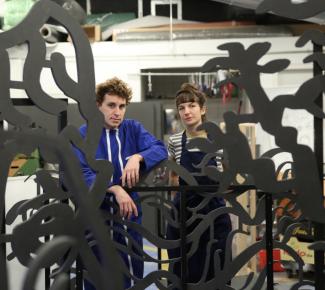Elvire Caillon & Léonard Martin | À l'oeuvre 2020
Elvire Caillon and Léonard Martin both studied at the Beaux-Arts de Paris.
Elvire Caillon is a visual artist. Her dual training at the Beaux-Arts de Paris and the École Estienne has led to collaborations in various fields: clothing at agnès b., music with the group Bagarre or the Cracki records label, illustration for the magazine INfluencia or the production company Les Indépendances. Her plastic work was noticed at the Salon de Montrouge, supported by residencies at the Friche de la Belle de Mai or the Villa Belleville, and awarded the Contemporary Drawing Prize of the Beaux-Arts de Paris.
Léonard Martin is a visual artist with a degree from Le Fresnoy - Studio national des arts contemporains et des Beaux-Arts de Paris. During his residency at the Villa Medici in Rome, he created a parade of gigantic figures inspired by the painting of the Quattrocento and the Giants of the North. These mobile sculptures were exhibited at the Palais de Tokyo as part of the Audi talents prize and paraded during the Nuit blanche in Paris.
Transcript
This project entitled Tempura Cockpit—a creation for the stage—began from a journey.
It began from a trip to Japan that we made last year, which we already had in mind as something of a scouting trip for an artistic project, although it was still quite abstract at that time.
More specifically, during the ‘A l’œuvre !’ residency what we are doing is creating part of the set.
Yes, we call it a set because it’s on a stage and is part of the show we’re creating; but we also consider the set as works in their own right.
The starting point is Elvire’s drawings, which are machined using a digital CNC machine, which allows us to have a kind of shadow play in space, but one on the scale of a human being.
It is used not so much for the shadows, but for the objects themselves, which are directly visible on the stage and thus become mobile sculptures.
The spectator takes pleasure both in seeing the illusion but also how it is made. We find it quite beautiful that the set can live on after the show. It raises this strange question: is a puppet that is not animated still alive?
